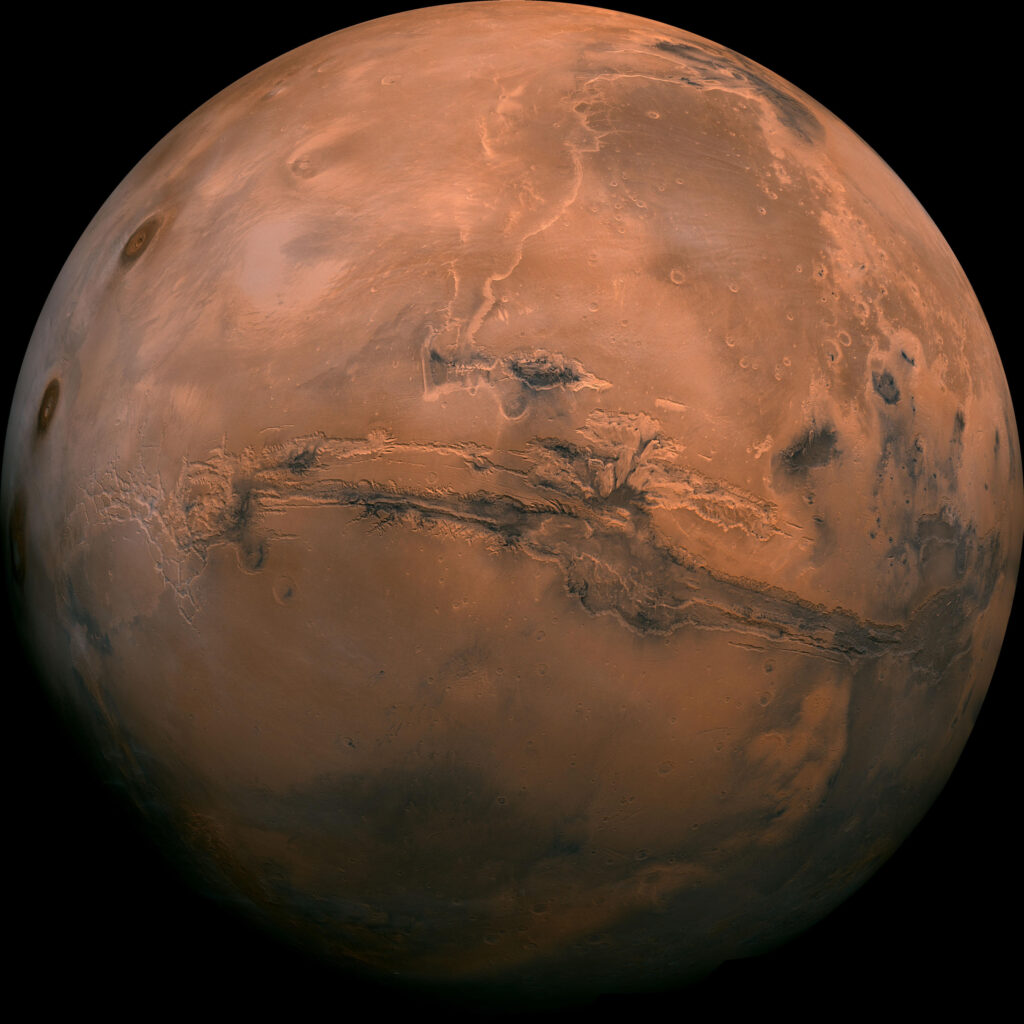Mars

Mars is the fourth planet from the Sun
Because of its exterior orbit, Mars ranges from close to the Sun to far from the Sun.
Perihelion is 1.38 A.U. (207 million km) from the Sun and its aphelion is 1.67 A.U. (249 million km) from the Sun, this causes great variation on planets climate.
Mars is brightest when earth lies between mars and the Sun.
Mars has a radius of 3397 km, or 0.53 Earth radii.
Martian gravity is round 40 percent that of Earth.
Mars has two small moons in orbit around it, unlike Mercury and Venus, named Phoebes and Deimos, which are probably asteroids captured early on in the planets history.
Mars has a mass of 6.4 x 1023 kg, or 0.11 that of Earth.
Mars has a density of 3900 kg/m3, only a little more then that of our Moon core composed mostly of iron sulfide and of a diameter of about 2500 km.
Mars rotates once on its axis every 24.6 hours, very similar to Earth.
Inclination to the orbit plain of around 24.0 degrees, very close to earths 23.5*, its orbital eccentricity, however, causes more intense seasonal changes than Earth.
Viking spacecraft visit in 1976. Viking landers took chemical analyses of the Martian regolith and found the surface to have high iron content.
American mariner 9 spacecraft went into orbit around Mars in 1971.
The Mars pathfinder and its robot rover Sojourner were the most recent visitors to
the planets surface in 1997.
Seasonal polar ice caps are mostly frozen carbon dioxide, or dry ice, while the permanent, residual cap may have small traces of water ice as well.
Mars has huge volcanoes, deep canyons, and vast dune fields.
Its northern hemisphere made up largely of rolling volcanic plains, similar to lunar maria and does not show as much evidence of cratering as does the south southern hemisphere made up largely of heavily cratered highlands located kilometers above the level of the northern lowland.
The Tharis Bulge, the most pronounced geologic feature of Mars, is the size of North America and lies on the Martian equator at about 10 km higher than the rest of the Martian surface.
The Valles Merineris is another incredible feature and follows the Martian equator for almost 4000 km, approximately one-fifth of the way around the planet. It ranges from 120 km across, to as deep as 7 km in places.
Mars has some of the largest shield volcanoes in the solar system, Olympus Mons is the largest and is only a little smaller then the state of Texas. The planets large volcanoes are a result of the planets low gravity. Volcanic activity is thought to have occurred as recently as 100 million years ago planet wide dust storms can obscure the entire landscape.
Temperatures on the planets surface range from 300k in the afternoon to 100k at night. Surface temperatures average about 50 k cooler than Earth.
The planet’s air is over 10,000 times thinner than that of Venus. The planets atmosphere is made up of 95.3 percent carbon dioxide 2.7 percent nitrogen, 1.6 percent argon, 0.13 percent oxygen, 0.07 percent carbon monoxide, and about 0.03 percent water vapor.
The Martian surface is covered with larger impact craters, but smaller ones have been eroded by the planets intense dust storms.
The liquid ejecta surrounded the craters suggests a thick layer of permafrost, of dendridic patterns resembling Earth’s rivers are further evidence of the planets watery past.
The planet’s magnetic field is on average a few thousandths of the strength of Earth’s field, in conjunction with the fact that the planet has a fast rotational period; this indicates a probable lack of a metallic or liquid core.
Mars lies outside Earth’s orbit, so it traverses the entire ecliptic plane, as seen from Earth. Its orbit is more elliptical than Earth’s, so its distance from the Sun varies more.
Mars rotates at almost the same rate as Earth, and its rotation axis is inclined to the ecliptic at almost the same angle as Earth’s axis. Because of its axial tilt, Mars has daily and seasonal cycles much like those on our own planet, but they are more complex than those on Earth because of Mars’s eccentric orbit.
From Earth, the most obvious Martian surface features are the polar caps, which grow and diminish as the seasons change on Mars. The appearance of the planet also changes because of seasonal dust storms that obscure its surface.
Like the atmosphere of Venus, Mars’s atmosphere is composed primarily of carbon dioxide. However, unlike Venus’s, the density of the cool Martian atmosphere is less than 1 percent that of Earth’s. Mars may once have had a dense atmosphere, but it was lost, partly to space and partly to surface rocks and subsurface permafrost and polar caps. Even today, the thin atmosphere is slowly leaking away.
Surface temperatures on Mars average about 50 K cooler than those on Earth. Otherwise, Martian weather is reminiscent of that on Earth, with dust storms, clouds, and fog.
The two polar caps on Mars consist of a seasonal cap, composed of carbon dioxide, which grows and shrinks, and a residual cap of water ice, which remains permanently frozen.
Mars’s major surface feature is the Tharsis bulge, located on the planet’s equator. It may have been caused by a “plume” of upwelling material in the youthful Martian mantle. Associated with the bulge is Olympus Mons, the largest known volcano in the solar system, and a huge crack, called the Valles Marineris, in the planet’s surface.